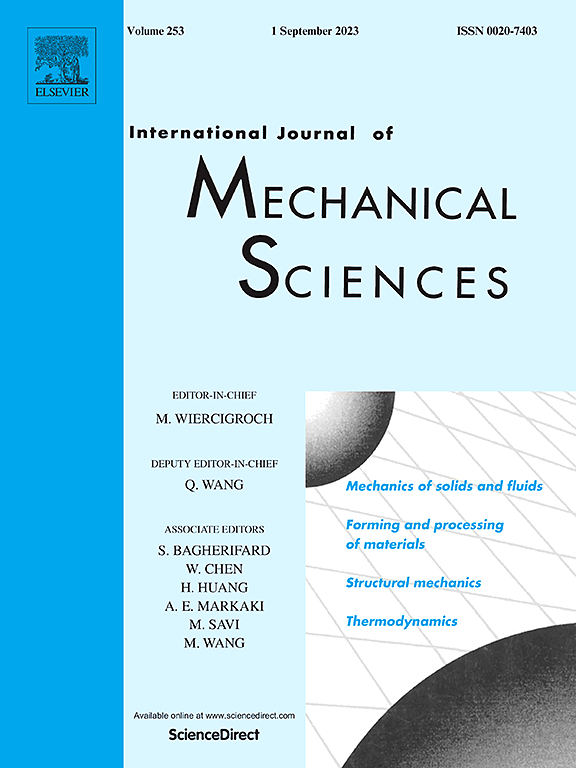Asynchronous contact modeling incorporating edge effects: Application to gear systems
IF 7.1
1区 工程技术
Q1 ENGINEERING, MECHANICAL
International Journal of Mechanical Sciences
Pub Date : 2025-07-12
DOI:10.1016/j.ijmecsci.2025.110600
引用次数: 0
Abstract
Many mechanical systems involve multiple interacting contact surfaces, where interference can significantly alter intended conditions. In gear transmissions, continuous meshing depends on coordinated multi-tooth engagement. Surface deviations and operational disturbances may induce asynchronous contact, modifying meshing behavior and load distribution. This study establishes a modeling framework to characterize asynchronous contact, explicitly incorporating multiple surface interference mechanisms. The model employs surface gap to characterize surface interactions, defining an initial contact state to quantify interference. The core of the contact algorithm is an iterative procedure that adjusts deformation to match the contact force under multi-surface interference conditions. Each contact region is treated as a complete or incomplete elliptical contact, determined by local profiles and proximity to surface boundaries. Cylindrical contact cases are simulated and validated through finite element analysis, while gear transmission analyses are conducted based on the developed model. Results reveal that micrometer-scale asynchronous contact induces substantial load imbalance, with local load deviations up to an order of magnitude higher than those in adjacent regions, indicating the extreme sensitivity of multi-surface contact systems to minor surface deviations.

结合边缘效应的异步接触建模:齿轮系统的应用
许多机械系统涉及多个相互作用的接触面,其中的干扰可以显著地改变预期的条件。在齿轮传动中,连续啮合依赖于协调的多齿啮合。表面偏差和操作干扰可能导致异步接触,改变网格行为和负载分布。本研究建立了一个建模框架来描述异步接触,明确地结合了多种表面干涉机制。该模型采用表面间隙来表征表面相互作用,定义初始接触状态来量化干涉。该接触算法的核心是在多面干涉条件下调整变形以匹配接触力的迭代过程。每个接触区域被视为一个完整或不完整的椭圆接触,由局部轮廓和接近表面边界确定。通过有限元分析对圆柱接触工况进行了仿真验证,并基于所建立的模型进行了齿轮传动分析。结果表明,微米尺度的异步接触引起了大量的负载不平衡,局部负载偏差比相邻区域的负载偏差高一个数量级,表明多表面接触系统对微小的表面偏差极为敏感。
本文章由计算机程序翻译,如有差异,请以英文原文为准。
求助全文
约1分钟内获得全文
求助全文
来源期刊

International Journal of Mechanical Sciences
工程技术-工程:机械
CiteScore
12.80
自引率
17.80%
发文量
769
审稿时长
19 days
期刊介绍:
The International Journal of Mechanical Sciences (IJMS) serves as a global platform for the publication and dissemination of original research that contributes to a deeper scientific understanding of the fundamental disciplines within mechanical, civil, and material engineering.
The primary focus of IJMS is to showcase innovative and ground-breaking work that utilizes analytical and computational modeling techniques, such as Finite Element Method (FEM), Boundary Element Method (BEM), and mesh-free methods, among others. These modeling methods are applied to diverse fields including rigid-body mechanics (e.g., dynamics, vibration, stability), structural mechanics, metal forming, advanced materials (e.g., metals, composites, cellular, smart) behavior and applications, impact mechanics, strain localization, and other nonlinear effects (e.g., large deflections, plasticity, fracture).
Additionally, IJMS covers the realms of fluid mechanics (both external and internal flows), tribology, thermodynamics, and materials processing. These subjects collectively form the core of the journal's content.
In summary, IJMS provides a prestigious platform for researchers to present their original contributions, shedding light on analytical and computational modeling methods in various areas of mechanical engineering, as well as exploring the behavior and application of advanced materials, fluid mechanics, thermodynamics, and materials processing.
 求助内容:
求助内容: 应助结果提醒方式:
应助结果提醒方式:


